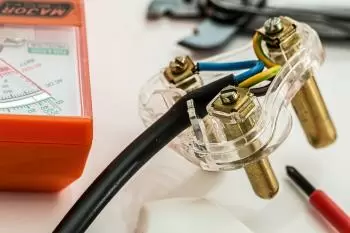
Electric current is the movement of positively and negatively charged particles through an electric conductor whose ends are subjected to different electric potentials. Typically, these charge carriers are negatively charged electrons, but they can also be positive charge carriers.
This flow of electrons allows electrical energy to be transported while generating an electric field and a magnetic field.
Currently, the electricity that reaches homes is in alternating current. This fact is due to the so-called "war of the currents." This war was produced in the second half of the 19th century and the dawn of the 20th in the USA. Nikola Tesla's proposal to use alternating current prevailed over Thomas Alva Edison's option to use direct current.
The SI unit for the electric current is the Coulomb corresponding to the amperage par second that crosses a conductor section.
All electric current flows belong to one of the following types of electric current:
-
Direct current (DC).
-
Alternating current (AC).
In turn, alternating current can be classified into sinusoidal, quasi-stationary, high frequency, eddy current, single-phase, and triphasic current.
Direct current (DC)
A direct current is a current whose direction and magnitude do not change in time.
For example, the electricity provided by the solar panels in a photovoltaic solar energy installation is obtained in direct current and then transformed into CA using an inverter. Static electricity is another example of DC.
In this current type, free electrons move from the negative terminal to the positive terminal. However, the conventional sense of the electric current is the opposite because they considered it a positive charge when it was established.
Alternating current (AC)
An alternating current is an electric current in which the direction of circulation of the flow of electric charge varies over time.
Any current that is not constant would fall within this classification. For example, the power inverters in a photovoltaic solar installation are responsible for converting the electricity obtained thanks to the photovoltaic effect into alternating current.
Sinusoidal current
Sinusoidal current is the most important type of periodic electric current(CA). Its waveform over time is a sinusoidal function.
The potential at each end of the electrical conductor changes concerning the potential at the other end. This variation is performed alternately from the positive terminal to the negative terminal, changing direction.
Quasi-stationary current
Quasi-stationary current is "a relatively slowly changing alternating current (CA), for whose instantaneous values the laws of constant currents hold with sufficient precision. The most significant of these laws are Ohm's law and Kirchhoff's rules.
Quasi-steady current, like direct current, has the same current intensity in all sections of an unbranched circuit.
Normal industrial currents are almost stationary, except for currents in long-distance transmission lines.
High-frequency electrical current
This type of current is an alternating current that works from a frequency of approximately tens of kHz. In it, phenomena such as electromagnetic radiation and skin effect become significant.
If the wavelength of alternating current radiation becomes comparable with the dimensions of the electric circuit elements and the quasi-stationary condition is violated.
Eddy current
Eddy currents are closed electrical currents in a massive conductor that occur when the magnetic flux penetrating it changes, so eddy currents are induction currents. The faster the magnetic flux changes, the stronger the eddy currents will be.
Eddy current from conductive materials leads to energy losses, especially in the cores of alternating current coils.
Single-phase current
A single-phase current is made up of a single alternating current (AC) or phase, and therefore all voltage varies in the same way.
Single-phase electricity distribution is often used when the loads are primarily for lighting and heating and small electric motors.
Single-phase installations are usually made up of three types of electrical cables:
-
The phase cable is the cable through which electric current circulates.
-
The neutral wire allows the current to return.
-
The ground wire provides a conduction path to the ground independent of single-phase current. The functionality of this cable is exclusively for protection to conduct possible overvoltages to the ground.
Triphasic current
A three-phase current is a set of three single-phase alternating currents (AC) of equal frequency and amplitude. Each phase has a phase difference between them of 120 electrical degrees.
The generators used in power plants are three-phase since the connection to the electrical network must be three-phase (except for low-power plants). In addition, three-phase is widely used in industries, where machines are powered by three-phase motors.